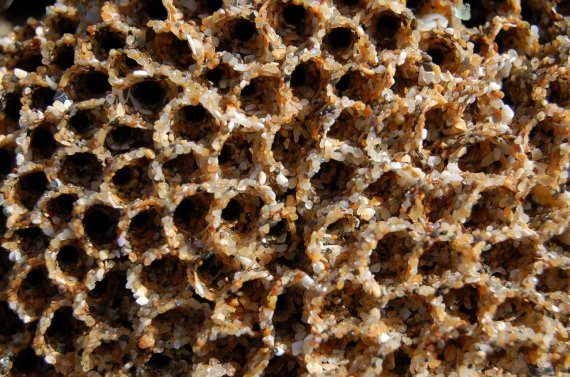Glue doesn’t stick to wet surfaces. Just try putting a plaster on wet skin. But getting things to stick together underwater is not impossible. Mussels and barnacles have no trouble sticking to a surface. And some marine worms create entire structures by sticking sand and bits of shell together underwater.
Bio-inspired design
This trick performed by marine worms is what Marco Dompé, an Italian PhD student in the Physical Chemistry and Soft Matter chair group, took as the starting point for his approach to developing underwater glue. This scientific field is known as bio-inspired design. ‘But please note, it is not just a matter of copying,’ emphasizes Dompé. ‘Nature is far too complex just to copy something. What we do is to use principles from nature to create something new.’
We use principles from nature to create something new
Marco Dompé, PhD candidate
The sandcastle worm (Phragmatopoma californica) uses coacervates as adhesives. ‘These are materials which are formed by mixing two polymers with opposite charges,’ explains Dompé. ‘Separately, those polymers are water-soluble. But when you combine those solutions they form a two-phase system.’ The charged polymers stick together and form a fluid-like substance, a coacervate adhesive that does not mix with water. This kind of glue hardens when it comes into contact with seawater, for example due to the acidity of the water or to exposure to oxygen. It depends which external stimulus the glue needs.
Body temperature
The external stimulus Dompé has concentrated on is temperature. That was not a random choice. The underwater glue he wants to make is intended for medical applications. It needs to be a substance that can be applied to precisely the right place in liquid form and then harden in response to the body temperature. ‘We have done it by attaching poly(N‐isopropylacrylamide) side chains to both polymers,’ Dompé explains. ‘Those side chains themselves are fully soluble in water. But at elevated temperatures, they clump together and repel the surrounding water.’ Arm in arm, the clingy side chains achieve the required hardening of the glue at body temperature. A physical process which is also irreversible.

Dompé did not start out as an organic chemist. He studied industrial chemistry in Turin. ‘Synthesizing polymers was totally new to me. It was hard work, and there were lots of ups and downs.’ But the result is quite something. The glue worked exactly as envisaged on the drawing board. ‘We’ve got the proof of concept, but the glue still has to be fully developed,’ he says. ‘Underwater, the glue is 10 times stronger than adhesive tape. That is not yet strong enough for medical applications, but we are on the right track. The big plus points of this glue are its thermo-responsiveness and the strength of the electrostatic interactions of the polymers.’
Patent
Meanwhile, the chair group has applied for a patent on the process. The strategy works. The rest is a question of pressing the right buttons. Dompé: ‘The material you use needs to be bio-compatible and non-toxic. That depends on the part of the body where you want to use the glue.’ Different polymers and side chains elicit different characteristics of the glue. The salinity of the environment in which the glue is applied is also important to the process. Dompé has done more research on that in follow-up experiments, the results of which are still to be published. Dompé hopes to graduate with his PhD in January 2020.

 Sandcastle worms (Phragmatopoma californica) build shelters for themselves by sticking sand and bits of shell together underwater.Photo: kqedquest
Sandcastle worms (Phragmatopoma californica) build shelters for themselves by sticking sand and bits of shell together underwater.Photo: kqedquest